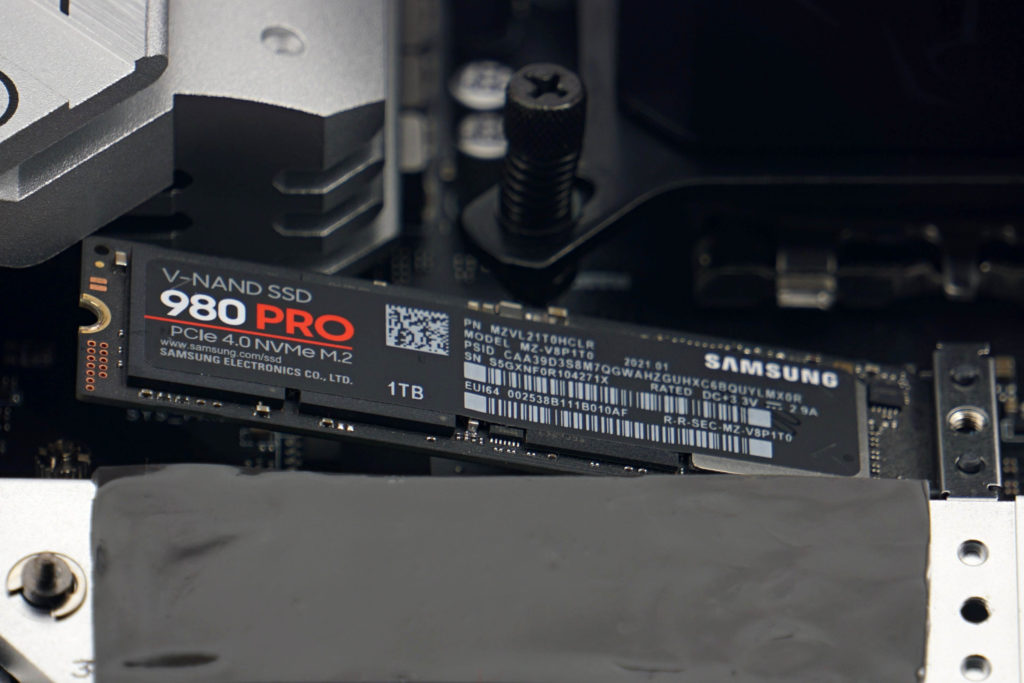Arctic M2 Pro cooler in detail
Arctic also offers SSD coolers. One of the leading brands is betting on low price, excellent compatibility and it also seems the visual impression is also important. However, the emphasis is also on high cooling performance and that the “improvement”, or reduction of (SSD) temperatures compared to a solution without a cooler is significant. What does this mean? For example, even minus 30 degrees Celsius.
Arctic M2 Pro cooler in detail
From a box resembling the packaging of chewing gum, you pull out three parts – the passive (with a preinstalled thermal pad), backplate, and thermal pad (for the backplate). No additional material is included.Installation manual is only available in electronic form.
The backplate is made of aluminum, its weight is quite low (5 g), but it still offers a high level of robustness. This is despite the fact that it is made of 0.8 mm thin sheet metal – the “U” profile is resistant to longitudinal bending. This means that even on motherboards that would tend to twist the SSD, flawless contact with the passive will be ensured. It (the passive) is already 24 grams. The stated weight (40.5 grams) is the total weight, i.e. including the thermal pads.
Compared to SSD coolers of similar height, the Arctic M2 Pro (10.5mm) will often have a higher weight. Because of the less articulated surface. For example, such Axagon CLR-M2L10 has significantly taller fins, in the Arctic M2 pro cooler they are only about 1.5 mm, and the overall height is more made up of again significantly thicker substrate (than in the Axagon cooler). It can be noted that the Arctic passive is “fuller”. And it has only three wider fins beveled on the shorter side at roughly a 60-degree angle. Their surface is distinguished from the rest by a sanded finish.
The surface of the passive is “sandblasted” on the sides. Arctic also took care to make the result visually impressive. And although the passive is black (or grey – the other “silver” variant), the contrast changes and the fins of the cooler are typically more pronounced due to the different surface treatment in different light. But you won’t miss the Arctic logo on the right side either.
You can start the installation by applying the thermal pad to the backplate. The first thing to do is to remove the protective film on one side, then prime the pad well and spread it as evenly as possible over the entire surface of the inside of the backplate. Then remove the other film of the thermal pad as well. Only one film comes off the passive, because the thermal pad is already pre-installed on it.
After preparing the backplane and passive, the SSD comes first with the bottom side to the backplate and then with the passive on top. Along the length, it is good to align the backplate with the passive well and then you just snap the two parts, with the SSD in between, together. The process requires no tools and is actually somewhat similar to the Gelid IceCap mounting system. In this case, however, the contact is tighter – the connecting trough is along the entire length of the cooler.
On the one hand (during installation) this is good, however, disassembly is more complicated. We found the technique of “peeling out” the passive with a knife on one side and the other to be useful. So that it peels away from the SSD. Theoretically, it would also be possible to push the passive out as it is in the rails, but this is very stiff going as there is high friction. This is also because of the high mounting pressure. Be careful not to damage the thermal pad or, and this would be worse, the SSD itself when disassembling.
The teeth that the backplate and the passive bite into each other clamp the SSD really hard.
SSDs in 80-millimeter M.2 format, both single-sided and double-sided, are supported.
One more note on the installation and possible complications: sometimes you will have to fit the backplate very precisely in order to install the SSD with the cooler. This is because with selected tool-less M.2 slot latches, there may be a collision. This is because the backplate does not have a semi-circular cutout on either side for the latch structure that is under the SSD. If the latter (M.2 slot latch) requires more space, it will collide with the backplate and will not secure the SSD.
In its manual, Arctic also warns not to let the backplate edge interfere with the highlighted part of the PCB of the SSD. It should be on top of this semicircle. But even that may not be enough, and even if it is enough, it may not turn out well on the other side, at the connector. If the backplate is moved too far forward, this location may again be the subject of a collision. And while these are rare cases where you can’t avoid the difficulties we’ve encountered, for example, in the lower slots of the Asus ROG Strix Z790-E Gaming WiFi motherboard, the mounting cutout in the backplate, as most SSD coolers have it, is in short kind of missed with the Arctic M2 Pro.
The cooler exceeds the PCI Express slot in height by approximately five millimeters. That’s still enough to allow many graphics card coolers to be in the space above the Arctic M2 Pro without making contact with each other here. With regard to cooling efficiency, this may not be the best position, but in any case, such an installation is possible.
Methodology
The tests take place in a wind tunnel that substitutes for a standard computer case. Four Noctua NF-S12A PWM@550 rpm fans are used for system cooling in a balanced ratio of two intake to two exhaust fans. The intake air temperature is strictly controlled and is kept within a narrow range of 21–21.3 °C for maximum possible accuracy.
In line with findings from measurements of the impact of different positions on cooling efficiency, we test standalone SSD coolers in the first slot, above the graphics card. From board tests we naturally have a lot of results of coolers (referred to as cooler 1 and cooler 2) from other positions as well, but in those cases, it is due to their fixed position.
For testing, we use a Samsung 980 Pro SSD (1 TB). The load is run for 10 minutes (which is enough time in the wind tunnel for temperatures to stabilize) in CrystalDiskMark – sequential read and write cycles. The achieved power draw then is about 6 W, which is the upper limit of what M.2 SSDs can do, and not even models with PCIe 5.0 interface support are supposed to change this.






















